Fava beans green as fresh spring grass (yes, even though we’re well into summer) graced our table this past weekend. I plucked our entire homegrown crop so that we could make a meal of them because, as I’ll soon explain, it takes a lot of fava beans and a lot of elbow grease to get a bowl of favas for dinner.
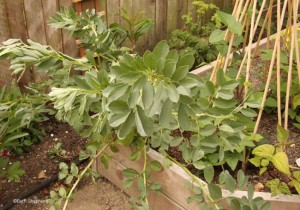 Vicia Faba, the Fava bean, is a “broad bean” also known as Windsor bean, English bean, horse bean and pigeon bean. The fava is among the most ancient plants in cultivation, and has long been a diet staple in Asia, the Middle East, South America, North Africa and Europe. In fact, they are the only beans Europeans ate before they discovered America and all its legumes. They took our beans home and left us the fava, which never really caught on (until recently).
Vicia Faba, the Fava bean, is a “broad bean” also known as Windsor bean, English bean, horse bean and pigeon bean. The fava is among the most ancient plants in cultivation, and has long been a diet staple in Asia, the Middle East, South America, North Africa and Europe. In fact, they are the only beans Europeans ate before they discovered America and all its legumes. They took our beans home and left us the fava, which never really caught on (until recently).
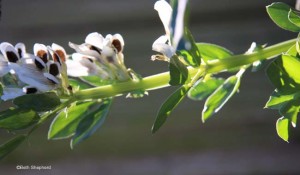 You figure out why as soon as you begin to prep your favas for feasting. First, you string and shuck the beans (ok, in my case, first you grow the beans!), then parboil them before removing the exterior waxy “shell” and popping out the bright shiny bean inside. It is something to do on a lazy sunny afternoon (now that we have them) on your back porch or around the kitchen table with a couple friends and a bottle of wine. It’s a lot of time to spend on a bean. But it is oh-so-worth-it!
You figure out why as soon as you begin to prep your favas for feasting. First, you string and shuck the beans (ok, in my case, first you grow the beans!), then parboil them before removing the exterior waxy “shell” and popping out the bright shiny bean inside. It is something to do on a lazy sunny afternoon (now that we have them) on your back porch or around the kitchen table with a couple friends and a bottle of wine. It’s a lot of time to spend on a bean. But it is oh-so-worth-it!
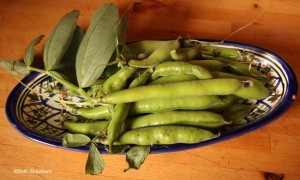 For me shelling the beans is almost meditative which is how I feel about gardening in general. Focus, focus, focus but without much actual thought and pretty soon you look around and see how much you’ve actually accomplished. Inner peace and dinner all at once.
For me shelling the beans is almost meditative which is how I feel about gardening in general. Focus, focus, focus but without much actual thought and pretty soon you look around and see how much you’ve actually accomplished. Inner peace and dinner all at once.
Unshelled, fresh favas look like giant, bumpy string beans. They are 5 to 7 inches long and lined with padding that looks like cotton batting. They grew happily and easily in my garden with lovely purple and white flowers late spring before the beans grew. My only gardening regret was that I didn’t plant more of them.
 Aside from the fava’s dubious distinction in ‘Silence of the Lambs,’ they are truly a bean to take note of. Nutritional powerhouses that are high in fiber and iron, and low in sodium and fat, they have no cholesterol but so much protein they are called the “meat of the poor.”
Aside from the fava’s dubious distinction in ‘Silence of the Lambs,’ they are truly a bean to take note of. Nutritional powerhouses that are high in fiber and iron, and low in sodium and fat, they have no cholesterol but so much protein they are called the “meat of the poor.”
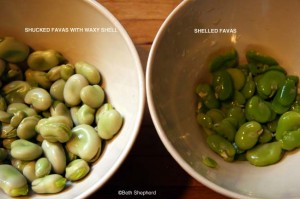 Italians even credit the fava bean as a factor in saving Sicilians from starvation during a time of famine. Since then, the fava has been considered good luck and is plays a key role on St. Joseph’s Day. Some people believe that if you keep one in the pantry, there will always be food in the kitchen.
Italians even credit the fava bean as a factor in saving Sicilians from starvation during a time of famine. Since then, the fava has been considered good luck and is plays a key role on St. Joseph’s Day. Some people believe that if you keep one in the pantry, there will always be food in the kitchen.
The only drawback that I can see to favas, besides the amount of labor you’ll exert to get them to your table, is that a small minority of people are affected by an enzyme deficiency called Favism. People who have this deficiency can experience severe effects after eating broad beans like fava.
Recipes for dining on favas are plentiful. I’ve had them mashed into a pate, mixed in a salad or served simply with olive oil, a squeeze of lemon and shavings of parmesan cheese. Big Papa and I enjoyed ours tucked into a divine risotto with asparagus (still a bit of local stalks left) and saffron. Our bowl of risotto paired wonderfully with grilled salmon…and a “nice Chardonnay” (thank you Anderson Family Vineyard).
No disrespect to Hannibal Lecter intended, but to my mind Chianti felt overpowering when I considered the nutty delicateness of fava beans. Granted Dr. Lecter savored his favas with a censor taker’s liver (and such a pairing trifecta it was as only a psychiatrist would know since favas, wine and liver are three no-no’s if one is taking MAO inhibitors used to treat depression).
So try your luck with the lucky bean. Put a dried fava in your pocket to ward off the effects of our sagging economy. Legend has it that you will never be broke as long as you carry one.
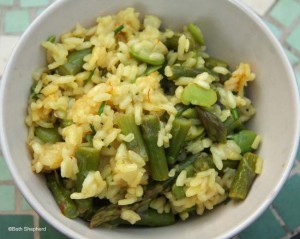 Recipe credit goes to Martha Rose Shulman and the New York Times. And, while I cannot claim to grow saffron-producing crocuses, I did substitute Walla Walla sweet onions from our garden in place of the spring onion. Chives were picked right outside the back door of the Urban Cabin.
Recipe credit goes to Martha Rose Shulman and the New York Times. And, while I cannot claim to grow saffron-producing crocuses, I did substitute Walla Walla sweet onions from our garden in place of the spring onion. Chives were picked right outside the back door of the Urban Cabin.
Risotto with asparagus, fava beans and saffron
- 2 pounds fava beans
- About 7 cups chicken or vegetable stock, as needed
- 2 tablespoons extra virgin olive oil
- 1/2 cup minced onion or spring onion* (*I substituted garden-fresh Walla Walla onions)
- Salt, preferably kosher salt, to taste
- 2 garlic cloves, minced
- 1 1/2 cups Italian arborio rice
- 1 pinch of saffron threads
- 1/2 cup dry white wine, such as pinot grigio or sauvignon blanc
- 1 pound asparagus, trimmed and cut into 1-inch pieces
- 1/2 cup freshly grated Parmesan cheese
- Freshly ground pepper to taste
- 2 tablespoons chopped chives (optional)
- Prepare the fava beans. Shell them while you bring a medium pot of water to a boil. Drop the beans into the water, and boil small favas for one minute, large favas for two minutes. Transfer at once to a bowl of ice-cold water. Drain. Remove the skins, using your thumbnail to open up the skin at the spot where the bean attached to the pod, then gently squeezing out the bean.
- Pour the stock or broth into a saucepan, and bring it to a boil. Add the asparagus, and blanch for three minutes. Remove the asparagus with a slotted spoon or skimmer, refresh in a bowl of cold water, drain and set aside. Turn down the heat under the stock, and keep at a simmer with a ladle nearby or in the pot. Make sure that it is well seasoned.
- Heat the oil over medium heat in a wide, heavy skillet or saucepan, and add the onion and 1/2 teaspoon salt. Cook, stirring, until tender, about three minutes. Add the garlic and the rice. Cook, stirring, until the grains of rice are separate and beginning to crackle, about one to two minutes. Rub the saffron between your thumb and fingers, and stir into the rice.
- Add the wine, and stir over medium heat until it has been absorbed by the rice. Begin adding the simmering stock, two ladlefuls (about 1/2 cup) at a time. The stock should just cover the rice and should be bubbling, not too slowly nor too quickly. Cook, stirring often, until the liquid is almost absorbed. Add another ladleful or two of the stock, and continue to cook in this fashion — adding more stock when the rice is almost dry, then stirring — for 15 minutes. Then stir in the asparagus and the fava beans and another ladleful or two of stock. Continue adding stock and stirring the rice for another 10 to 15 minutes, until the rice is cooked al dente and the vegetables are tender. Add more stock to the rice, and stir in the Parmesan, pepper and chives. Remove from the heat. Taste and adjust salt. The rice should be creamy. Stir once and serve right away in wide soup bowls or on plates.
Yield: Serves four to six
Advance preparation: You can begin this recipe several hours ahead and finish it just before serving. Cook halfway through step 4 — that is, for about 15 minutes. The rice should still be hard when you remove it from the heat. Spread in an even layer in the pan, and arrange the asparagus and favas over the top. Fifteen to 20 minutes before serving, bring the remaining stock back to a simmer and reheat the rice. Resume cooking as instructed. The favas can be blanched and shelled a day or two ahead and refrigerated.
Bonkers for beans and more? Check out Wanderfood Wednesday!
I’ll have to give this recipe a try. I’m a big fan of saffron. Thanks for sharing!
If the favas are just too much work, I think it would be delicious with asparagus alone.
The favas do seem like a lot of work, but completely worth it! And Chardonnay sounds like a better pairing than Chianti. 🙂
Glad you enjoyed my post. I took at a look at your blog as well…your Fava Bean Crostini sounds delish! If only I had more fava beans!
Hey, thanks for the nice mention of our Chardonnay. Fava beans will be in next years garden. Cheers! Cliff, Anderson Family